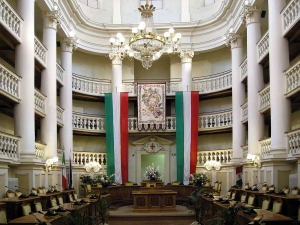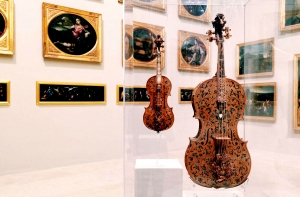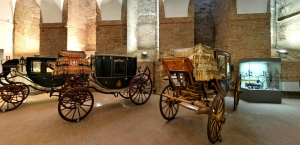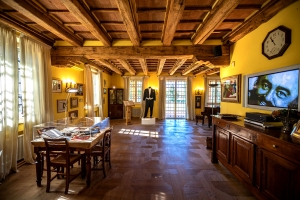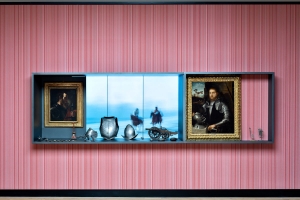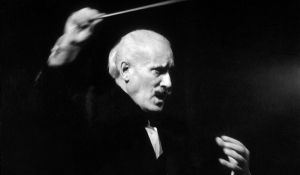Itinera Emilia
Reggio Emilia, Napoleon and the first Italian Flag
The Tricolore or Italian Tricolour Flag first flapped on 7th January 1797.
Where? Right here, in the Tricolour Hall in Reggio Emilia.
For a city tired to be ruled by the Este Family, the young Napoleon and France represented shared ideals of Freedom, Equality and Fraternity.
Chased away the Este Duke, the local representatives gathered together with those of Modena, Bologna and Ferrara in a large hall where the flag of the Cispadan Republic was presented for the first time.
A kind of tribute to the French flag where blue gave way to green.
If you enter that place today, the so-called Sala del Tricolore (Tricolour Hall), you can still breathe the same atmosphere: full of energy, pride and passion for freedom
Along the river with the ancient pilgrims: Bobbio and the Trebbia Valley
A land of wind, sandy shores and pilgrims’ paths.
If you want to understand this territory, you have to follow the river.
The Rivalta Castle, the Travo Archeological Park, the Hunchback Bridge and the Saint Colombanus Abbey in Bobbio, they are all along the Trebbia River.
A fundamental junction for the medieval pilgrims who set out along the Abbots’ Way, an alternative way to the ‘classic’ Francigena to get to Rome.
A river that keeps telling us ancient stories and that offers, with its still clear and bathing waters, a full contact with nature.
The Estense Gallery, memories of a dukedom
If you want to travel through time, you have to walk along these corridors.
A path from the Roman vestiges to the splendours of the Dukedom: this is the Estense Gallery of Modena.
It is just the marble portrait bust of Francesco I by Gian Lorenzo Bernini that welcomes us.
The Duke looks far away while the wind lifts up his cloak.
Thanks to the talent of Bernini it appears to be made of soft fabric. We forget that it is carved!
The Gallery houses also paintings and collector’s items. The musical instruments are amazing.
The carving decoration applied to violin making has incredible effects, almost exaggerated.
Stunning the famous Estense harp, made in 1581 and played in honour of Margherita Gonzaga by a female ensemble.
It’s show time: the main Theatres of Reggio Emilia
Reggio Emilia or, in other words, three theatres in a tiny plot of land. Built in the area of the ancient citadel, they enable the staging of almost all types of theatre productions.
The best known is the Valli Theatre. A traditional Italian opera house where Luciano Pavarotti made his debut in 1961. The neoclassical style of the exterior and interior decorations make it the young cousin of Parma's Regio Theatre.
To its right the Ariosto Theatre, dedicated to prose. It shares with the third theatre, known as La Cavallerizza, an... equine background. The first could host equestrian performances while the second was used for training horses. Now it is a theatre with adaptable spaces, an ideal venue for special projects
The City Museums: between ancient livers and carriages
Palazzo Farnese in Piacenza is the current seat of the Musei Civici (City Museums).
Theatre of the brutal murder of the Duke Pier Luigi Farnese, this historic building has become a huge box for masterpieces and precious objects like the Etruscan Liver, the very sweet Botticelli Tondo (rounded painting), the ducal frescoed apartments and much more.
Don’t miss the giant basement where you’ll discover the secret life of the court.
Right there you will find the Carriage Museum, second only to that of the Quirinale Palace in Rome. It takes us (this verb fits perfectly...) throughout the history of the European way of life from 18th century to the Modern Age.
The Porticoes of Bologna: World Heritage Site
An important recognition has brightened the summer of 2021 throughout the Emilia Romagna region.
UNESCO has confirmed the uniqueness of the arcades of Bologna, architectural structures that cross the city for 62 km, 40 of which in the old town centre, declaring them a World Heritage Site.
Born in the Middle Ages as building abuses in order to acquire living space, they are now meeting points, alternative pedestrian routes, protection from bad weather.
It is said, in fact, that a true bolognese is able to cross the city from one side to the other on a rainy day without getting wet!
They shelter from rain and snow but they also shelter from the sun!
They work as wonderful unusual routes for our guides during our winter visits in the beautiful city of Bologna.
Big Luciano and his daily music
The entrance gate is simple. The narrow path leads to a beautiful country house, a solid full of colours structure. Pavarotti’s peaceful retreat in Modena says a lot about him: a famous man deeply anchored to his roots.
At the ground floor his flowery shirts, his deck of cards, his own intense paintings, and his piano welcome us. Pavarotti’s voice is everywhere, singing cheerfully his favourite music.
Upstairs light becomes the protagonist together with the memories and the awards received all over the world.
And more music around, it seems to follow us through the corridors of the house.
In the last room, a bit hidden, a film is projected.
We see images stolen from the daily life of Pavarotti in Modena: so warm with his family and ready to joke with friends ever of a lifetime.
The City Museums: between Natural History and Photography
If they were to shoot the Italian version of ‘Night at the Museum’, this would be the appropriate venue. Rhinos, giraffes, lions, stuffed bears seem to be just waiting for the museum doors to be closed to come to life again.
The original nucleus of the Civic Museums of Reggio Emilia began, in fact, with the purchase of Lazzaro Spallanzani's naturalistic collection and expanded following different lines: historical, scientific, and artistic.
There is so much to see, including nineteenth-century and modern lay-outs, all the way to interactive spaces.
Two suggestions: let yourself be amazed by the barbaric Roman treasure and take your time to admire the section dedicated to the Reggio Emilia photographer Luigi Ghirri. Themes that are chronologically distant but representative of the history of Reggio Emilia.
Toscanini: talent and rigour
Conceived, according to his own words, between adventures of his father, a Garibaldian soldier, Arturo Alessandro Toscanini was born on March 25, 1867. His prodigious memory and extraordinary musical ear earned him admission to the Royal School of Music (the current Arrigo Boito Conservatory) in Parma.
Serious, tireless in studying, he reacts to the iron discipline of the Conservatory with memorable jokes such as "the mockery of the moustache" when together with some of his classmates he cuts off the moustache of the hated tutor who is peacefully sleeping in the common room.
Toscanini grew up musically in Parma where, for obvious geographical reasons, Verdi music was mainly played.
On the Christmas night of 1883, Parma hosted the first Italian performance of Wagner's Lohengrin. For the student Toscanini, who attended the show from the orchestra as a cellist, it was love at first sight, or rather, first ear. The novelty and originality of this new music made Arturo take an unshakable decision: he would never compose again. The spectators at the Teatro Regio in Parma were divided into two opposing factions: for and against Wagner. In any case Toscanini's musical career will be deeply marked by both composers.
Verdi's Aida is his first orchestral direction, an occasional debut. He went on tour to Brazil as a cellist when he was only 19 years old and had to replace the conductor who was challenged by the orchestra members who did not think he was good enough. He took the podium in Rio De Janeiro and conducted by heart. It was a triumph.
The return home means a return to the role of cellist and to Verdi, for whom he plays at the premiere of Otello at La Scala. The rigor in execution, that the Maestro demanded under Toscanini's eyes, will become one of his characteristic feature as a conductor. A rigor obtained in a very energetic way. It is said that, when his American orchestra made mistakes, Toscanini would start screaming in English to switch to Italian and then end up, furiously, in Parma dialect.
He interrupts his collaboration with the Wagner Festival of Bayreuth, despite being the only non-German musician invited, for political reasons. To the telegram of Hitler that in 1933 exhorts him to remain he answers: 'With you, never'.
He began his carreer with Verdi and ended it with Wagner. On April 4, 1954 Toscanini falters on the podium while conducting the New York NBC orchestra, he covers his eyes with one hand, he continues but is unable to complete the Prelude of Tannhauser.
After 68 years of an extraordinary career, the time had come to rest.
Parma Grand Tour
The Grand Tour was a journey through Europe reserved to the descendants of noble and rich families who, in the past centuries, thus perfected their knowledge. Italy was an essential destination and Parma was often part of the itinerary.
Our walking itinerary is a short Grand Tour to discover the great classics of Parma. A journey through its most important monuments such as the Cathedral and the Baptistery, the Palazzo della Pilotta, the facades, the narrow streets and the most beautiful and significant squares in the history of the city, supported by the narration of a local guide.
For those who wish, it is of course possible to enrich the visit with the interiors of the museums or churches that are part of the great artistic heritage of the city.
Suitable for those who do not know Parma and also for those who live there but have never had time for a close contact with the beauty of the place where they live.
